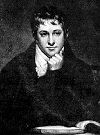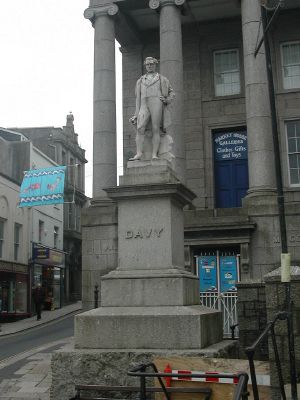Humphry Davy
|
Sir Humphry Davy | |
|---|---|
| File:Sir Humphry Davy2.jpg Sir Humphry Davy | |
| Born |
December 17, 1778 |
| Died | May 29, 1829 |
| Field | Physicist and Chemist |
| Institutions | Royal Institution |
| Notable students | Michael Faraday |
| Known for | Electrolysis, Chlorine, Davy lamp |
Sir Humphry Davy, 1st Baronet, FRS (17 December 1778 – 29 May 1829) was an esteemed British chemist and physicist. He was born in Penzance, Cornwall, United Kingdom and both his brother John Davy and cousin Edmund Davy were also noted chemists. Berzelius called Davy's 1806 Bakerian Lecture "On some Chemical Agencies of Electricity" "one of the best memoirs which has ever enriched the theory of chemistry."[1] This paper was central to any chemical affinity theory in the first half of the ninteenth century.[2]
Biography
Sir Humphry revelled in his status, as his lectures gathered many spectators. Davy became well known due to his experiments with the physiological action of some gases, including laughing gas (nitrous oxide) - to which he was addicted, once stating that its properties bestowed all of the benefits of alcohol but was devoid of its flaws. Davy later damaged his eyesight in a laboratory accident with nitrogen trichloride. In 1801 he was nominated professor at the Royal Institution of Great Britain and Fellow of the Royal Society, over which he would later preside.
Electrochemistry work
In 1800, Alessandro Volta announced his invention of the first electric pile or battery. Davy used this electric battery to separate salts by what is now known as electrolysis. With many batteries in series he was able to separate elemental potassium and sodium in 1807 and calcium, strontium, barium, and magnesium in 1808, which is when he also discovered and named aluminum. He also studied the energies involved in separating these salts, which is now the field of electrochemistry. According to the historian Christopher Lawrence, in the book Romanticism and the Sciences, his electrolytic work was driven by Romantic beliefs in a unity in nature, composed of polar forces.
Retirement and further work
In 1812 he was knighted, gave a farewell lecture to the Royal Institution, and married a wealthy widow, Jane Apreece. While generally acknowledged as being faithful to his wife, their relationship was stormy and in his later years Davy travelled to continental Europe alone. In October 1813 he and his wife, accompanied by Michael Faraday as his scientific assistant (and valet) traveled to France to collect a medal that Napoleon Bonaparte had awarded Davy for his electro-chemical work. Whilst in Paris Davy was asked by Gay-Lussac to investigate a mysterious substance isolated by Barnard Courtois. Davy showed it to be an element, which is now called iodine. The party left Paris on December 29, travelling south through Montpellier and Nice and then to Italy.
After passing through Genoa, they went to Florence, where, in a series of experiments starting on Sunday March 27, Davy, with Faraday's assistance, succeed in using the sun's rays to ignite diamond, and proved that it was composed of pure carbon. Davy's party continued on to Rome, and also visited Naples and Mount Vesuvius. By the June 17, they were in Milan, where they met Alessandro Volta, and continued north to Geneva. They returned to Italy via Munich and Innsbruck, passed though Venice and returned to Rome. Their plans to travel to Greece and Constantinople (Istanbul) were abandoned after Napoleon's escape from Elba, and they returned to England.
Agricultural chemistry
In 1813 Davy published the Elements of agricultural chemistry the translation of a course of lectures prepared for the Board of agriculture. The work was the first texbook of agricultural chemistry in the history of agrarian knowledges ."[3].
Davy lamp
After his return to England in 1815, Davy went on to produce the Davy lamp which was used by miners, although there is evidence to show that Davy "invented" his device at about the same time as an engineer, George Stephenson, but claimed all the credit for the invention.
He also showed that oxygen could not be obtained from the substance known as oxymuriatic acid and proved the substance to be an element, which he named chlorine. (However Carl Scheele is credited as the discoverer of chlorine. Scheele had discovered it 36 years before Davy, but was unable to publish his findings.) This discovery overturned Lavoisier's definition of acids as compounds of oxygen.
Acid and bases studies
In 1815 Davy suggested that acids were substances that contained replaceable hydrogen – hydrogen that could be partly or totally replaced by metals. When acids reacted with metals they formed salts. Bases were substances that reacted with acids to form salts and water. These definitions worked well for most of the century. Today we use the Brønsted-Lowry theory of acids and bases.
In 1818, he was awarded a baronetcy and two years later he became President of the Royal Society.
Further electrochemistry studies
In 1824 he proposed and eventually mounted chunks of iron to the hull of a copper clad ship in the first use of cathodic protection. Whilst this was effective in preventing the corrosion of copper, it eliminated the anti-fouling properties of the copper hull, leading to the attachment of molluscs and barnacles to the "protected" hull, slowing these ships and requiring extensive time in dry docks for defouling operations.He discoverd Calcium in 1808 in London England.
Death
Davy died in Switzerland in 1829, his various inhalations of chemicals finally taking its toll on his health. He is buried in the Plain Palais Cemetery in Geneva.
Davy's laboratory assistant, Michael Faraday, went on to enhance Davy's work and in the end became more famous and influential – to such an extent that Davy is supposed to have claimed Faraday as his greatest discovery. However, he later accused Faraday of plagiarism, causing Faraday (the first Fullerian Professor of Chemistry) to cease all research in electromagnetism until his mentor's death.
Davy's Statue
In the town of Penzance in Cornwall a statue of Davy, its most famous son, stands in front of the imposing Market House, now owned by Lloyds TSB, at the top of Market Jew Street, the town's main high street.
School
There is a secondary school in Penzance named Humphry Davy School [1]
Miscellanea
- Davy was the subject of the first ever clerihew:
- Sir Humphry Davy
- Abominated gravy.
- He lived in the odium
- Of having discovered sodium.
- Like James Prescott Joule and Isaac Newton, Davy is remembered in his hometown by a local pub. The Sir Humphry Davy pub is located in Penzance opposite the Geenmarket at the end of Market Jew Street.
- The lunar crater Davy is named after Sir Humphry Davy. It has a diameter of 34 km and coordinates of 11.8S, 8.1W.
ReferencesISBN links support NWE through referral fees
- ↑ J.J. Berzelius, Traite de chimie, trans. Jourdian and Esslinger, vol. 1, pg. 164. 1st Swedish ed. (Larbok i kemien), Stockholm (1818), this ed., 8 vol., Paris (1829-33).
- ↑ Levere, Trevor, H. (1971). Affinity and Matter – Elements of Chemical Philosophy 1800-1865. Gordon and Breach Science Publishers. ISBN 2881245838.
- ↑ Antonio Saltini, Storia delle scienze agrarie, vol II, I secoli della rivoluzione agraria, Edagricole, Bologna, 1984, pp.633-648.
External links
- Works by Humphry Davy. Project Gutenberg
bs:Humphry Davy bg:Хъмфри Дейви ca:Humphry Davy cs:Humphry Davy da:Humphry Davy de:Humphry Davy es:Humphry Davy eo:Humphry Davy fa:هامفری دیوی fr:Humphry Davy gd:Humphry Davy gl:Humphry Davy hr:Humphry Davy it:Humphry Davy he:האמפרי דייווי nl:Humphry Davy ja:ハンフリー・デービー no:Humphry Davy nn:Humphry Davy nov:Humphry Davy pl:Humphry Davy pt:Humphry Davy ru:Дэви, Гемфри simple:Humphrey Davy sk:Humphry Davy sl:Humphry Davy sr:Хамфри Дејви fi:Humphry Davy sv:Humphry Davy vi:Humphry Davy ur:سر ہمفری ڈیوی zh:汉弗里·戴维


